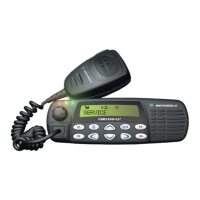2-34 Theory of Operation
The driver contains a data interface to the
IJP,
an LCD segment driver, an LCD power circuit, an
oscillator, data RAM and control logic. At power up the driver's control logic is reset by a logic 0 at
input
SR2 (U0971-15). The driver's internal oscillator
is
set
to
about
20kHz
and can be measured at
pin 22. The driver's
IJP
interface is configured
to
accept 8 bit parallel data input (U0971-DO-D7) from
the
control head
IJP
(U0831 port PCO-PC7).
To
write data to
the
driver's RAM the
IJP
sets chip select (U0971-20)
to
logic 0 via U0831-11, RD
(U0971-18) to
logic 1 via (U0831-10) and WR (U0971-17)
to
logic 0 via U0831-9. With input
AO
(U0971-21) set
to
logic 0 via U0831-12 the
IJP
writes control data
to
the driver. Control data includes
the RAM start address for the following display data. With input
AO
set to logic 1 the
IJP
then writes
the
display data to the display RAM. When data transfer
is
complete the
IJP
terminates the chip
select,
RD,
and
WD
activities.
The display driver's power circuit provides the voltage supply for the display. This circuit consists
of
a
voltage multiplier, voltage regulator and a voltage follower. The external capacitors C0971 - C0973
configure the multiplier
to
double the supply voltage.
In
this configuration the multiplier output VOUT
(U0971-8) supplies a voltage
of
-5V (2* -5V below VDD). The multiplied voltage VOUT is sent to the
internal voltage regulator.
To
set the voltage level
of
the regulator output V5 (U0971-5) this voltage
is
divided by the resistors R0973 and R0974 and fed back to the reference input VR (U0971-6).
In
addition the regulator output voltage V5 can
be
controlled electronically by a control command sent
to the driver. With the used configuration the
voltage V5
is
about
-2V.
The voltage V5 is resistively
divided by the driver's voltage follower to provide the voltages
V1
- V4. These voltages are needed
for driving the
liquid crystals. The level of V5 can be measured by one
of
the
IJP's
analog-to-digital
converters (U0831-20) via resistive divider R0975, R0976.
To
stabilize the display brightness over a
large temperature range the
IJP
measures the temperature via analog-to-digital converter (U0831-
18) using temperature sensor
U0834. Dependent on the measured temperature
the
IJP
adjusts the
driver output
voltage V5, and in turn the display brightness, via parallel interface.
2.1
0.8 Microphone Connector Signals
Signals BUS+,
PTI
IRDEC, HOOK, MIC,
HANDSET
AUDIO, FLT A+, +5V and 2
AJD
converter
inputs are
available at the microphone connector J0811. Signal BUS+ (J0811-7) connects to the
SBEP bus for communication with the CPS
or
the Universal Tuner. Line MIC (J0811-5) feeds the
audio from the microphone to the radio's
controller via connector J0801-4. Line
HANDSET
AUDIO
(J0811-8) feeds the receiver audio from the controller (J0801-6)
to
a connected handset.
FLT
A+,
which
is
at supply voltage level, and +5V are used to supply any connected accessory like a
microphone or a handset.
The two
AJD
converter inputs (J0811-9/10) are used as a microphone with keypad. A pressed key
changes the de
voltage on both lines. The voltages depend on which key is pressed. The
IJP
determines, from
the
voltage
on
these lines, which key is pressed and sends this information
to
the
host radio.
Line
PTI
IRDEC (J0811-6)
is
used to key up the radio's transmitter. While the
PTI
button on a
connected microphone is
released, line PTT IRDEC line
is
pulled to a +5 volts level by R0843.
Transistor Q0843 is then switched on causing a low at
IJP
port PA2. When the PTT button
is
pressed,signal PTT IRDEC is pulled
to
ground level. This switches
off
Q0843 and the resulting high
level at
IJP
port PA2 informs the
IJP
about
the
pressed PTT button. The
IJP
informs
the
host radio
about any status change on the
PTI
IRDEC line via the SBEP bus.
When
line PTT IRDEC
is
connected
to
FLT
A+ level, transistor Q0821
is
switched on through diode
VR0821 pulling
the
level on
the
line ON OFF CONTROL to FLT A+ level. This switches on the radio
and puts the radio's
IJP
in bootstrap mode. Bootstrap mode is used
to
load the firmware into the
radio's
flash memory.
The HOOK input (J0811-3) is used to inform the
IJP
when the microphone's hang-up switch
is
engaged. Dependent on the CPS programming the
IJP
may take actions like turning
the
audio
PA
on
or off.
While the hang up switch is open, line HOOK
is
pulled
to
+5 volts level by R0841. Transistor

